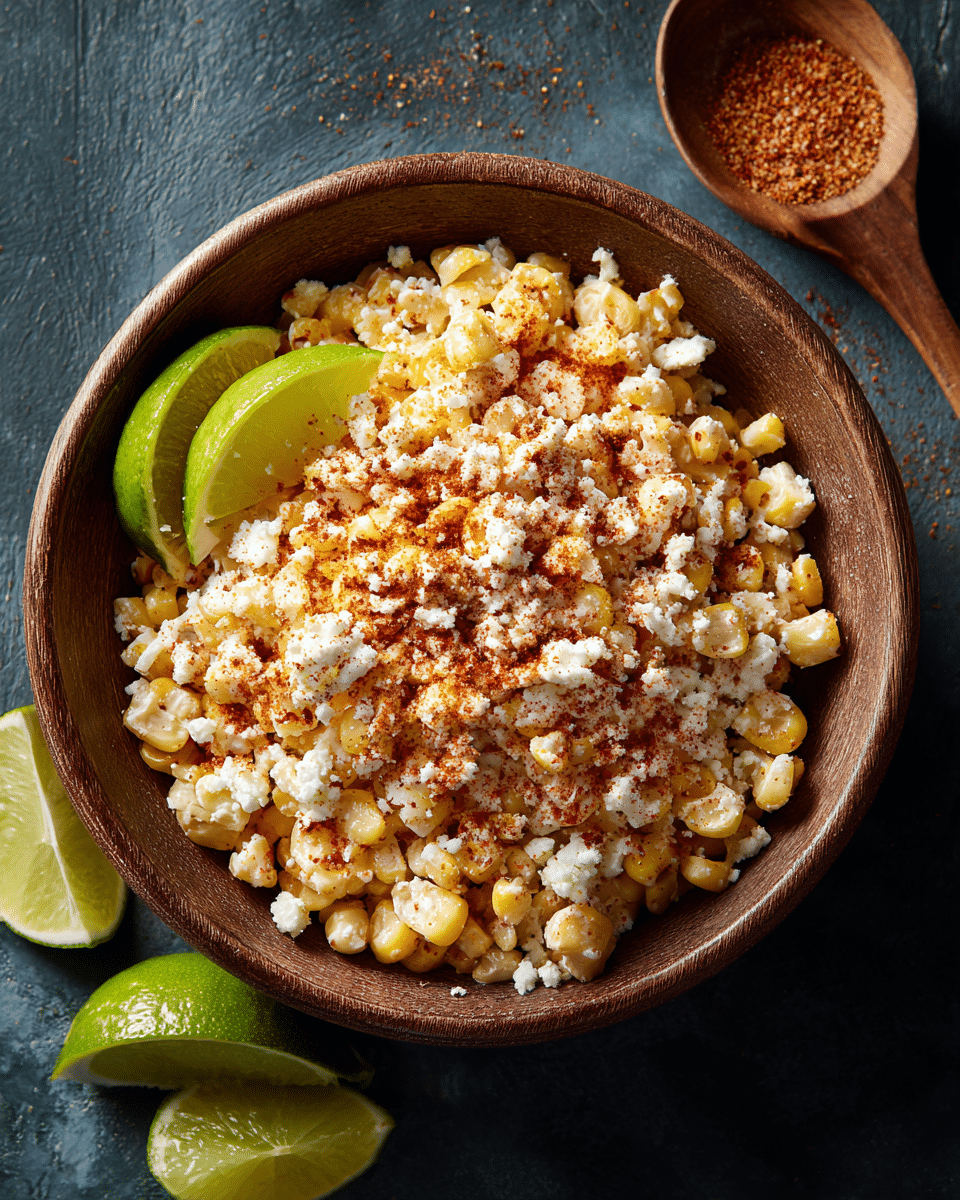Esquites, often referred to as Mexican street corn in a cup, is a popular and irresistible snack found at street stalls and markets throughout Mexico. This creamy, tangy, and slightly spicy dish combines sweet corn kernels with mayonnaise, lime juice, chili powder, and crumbly Cotija cheese.
FULL RECIPE
Ingredients
- 4 cups fresh or frozen corn kernels (about 6 ears of corn)
- 2 tablespoons unsalted butter
- 1/4 cup mayonnaise
- 1/4 cup Mexican crema or sour cream
- 1/2 cup Cotija cheese, crumbled
- 1 tablespoon lime juice (about 1/2 lime)
- 1/2 teaspoon chili powder (plus more for garnish)
- 1/4 teaspoon smoked paprika (optional)
- Salt, to taste
- Freshly ground black pepper, to taste
- Fresh cilantro, chopped (for garnish)
- Lime wedges, for serving
Directions
- In a large skillet over medium-high heat, melt the butter.
- Add the corn kernels and cook, stirring occasionally, for 5–7 minutes, until lightly charred and heated through.
- Reduce heat to medium and stir in the mayonnaise and Mexican crema until the corn is evenly coated.
- Add the lime juice, chili powder, smoked paprika (if using), salt, and pepper. Stir well to combine.
- Remove from heat and mix in most of the Cotija cheese, reserving some for garnish.
- Spoon the esquites into serving cups or bowls.
- Top with remaining Cotija cheese, a sprinkle of chili powder, chopped cilantro, and a lime wedge.
- Serve warm and enjoy immediately.
Nutrition Facts
- Calories: 210
- Total Fat: 15g
- Saturated Fat: 6g
- Cholesterol: 20mg
- Sodium: 300mg
- Total Carbohydrates: 16g
- Dietary Fiber: 2g
- Sugars: 4g
- Protein: 5g
Cultural Significance of Esquites
Esquites hold a special place in Mexican street food culture, offering a comforting blend of flavors that reflects the country’s culinary diversity. This dish is commonly sold in cups by street vendors, often with the steam rising from freshly cooked corn mixed with tangy, creamy, and spicy seasonings. It’s especially popular during celebrations like Mexican Independence Day, where it complements the vibrant atmosphere of parades, music, and fireworks. The recipe’s simplicity makes it accessible to all, while its customizable toppings allow for regional variations that tell the story of local tastes and traditions.
Nutritional Value of Corn
Corn, the star ingredient of esquites, is a good source of dietary fiber, essential vitamins, and minerals. It contains B vitamins, which are important for energy metabolism, and minerals like magnesium and potassium that support overall body function. While corn is naturally higher in carbohydrates, its complex structure means it provides a slow release of energy, keeping you fuller for longer. In moderation, esquites can be part of a balanced diet, especially if paired with fresh vegetables and lean protein to round out the meal.
Role of Cotija Cheese in Flavor
Cotija cheese is known as the “Parmesan of Mexico” due to its crumbly texture and salty, tangy flavor. In esquites, Cotija balances the sweetness of the corn and the tartness of the lime, while also adding a savory depth that makes each bite more satisfying. The cheese doesn’t melt like other varieties, so it remains visible and texturally distinct in the dish, providing a delightful contrast. Its sharpness ensures that even a small sprinkle has a big impact, making it both a flavorful and economical addition.
Importance of Lime and Chili Powder
The combination of lime juice and chili powder is essential to achieving the bold, zesty profile that makes esquites so irresistible. Lime juice brightens the dish, cutting through the creaminess of mayonnaise and crema, while chili powder adds a mild heat that enhances rather than overwhelms. This pairing is a hallmark of Mexican street snacks, offering a balance of acidity, spice, and warmth that wakes up the palate. Smoked paprika or other chili blends can be used to add more complexity without changing the core flavor profile.
Variations Across Mexico
While the base recipe for esquites remains consistent, regional differences give the dish a variety of personalities. In some parts of Mexico, vendors may add epazote, a native herb that lends a slightly earthy, pungent note. Others might incorporate roasted poblano peppers, diced jalapeños, or even shrimp for a more indulgent twist. The choice of toppings can vary as well—some prefer queso fresco instead of Cotija, while others add a splash of hot sauce for extra heat. These adaptations ensure that no two servings of esquites are exactly alike.
Serving Suggestions
Esquites are traditionally served in disposable cups with spoons, making them an ideal portable snack. For a home or party setting, they can be served in small bowls or even in martini glasses for a more elegant presentation. Garnishing with fresh cilantro, extra Cotija, or thinly sliced radishes can elevate the look and flavor. They pair beautifully with grilled meats, tacos, or quesadillas, and can be a great addition to a buffet or appetizer table during celebrations. Serving them warm brings out the best in the creamy sauce, but they can also be enjoyed at room temperature.
Pairing with Beverages
The bright, tangy, and slightly spicy profile of esquites makes them a versatile companion for a range of beverages. They work well with light beers such as lagers or pilsners, which complement the corn’s sweetness and balance the spice. For a non-alcoholic option, aguas frescas like horchata, hibiscus tea, or tamarind water offer refreshing contrasts. A zesty margarita or paloma also pairs beautifully, enhancing the citrus notes in the dish while providing a festive touch.
Storage and Reheating Tips
If you have leftover esquites, store them in an airtight container in the refrigerator for up to three days. The flavors often deepen after a few hours, making them just as delicious the next day. When reheating, do so gently on the stovetop or in the microwave to avoid overcooking the corn, which can become tough. It’s best to add fresh lime juice, Cotija, and any garnishes just before serving to preserve their brightness and texture. Freezing is not recommended, as the creamy dressing and cheese can separate upon thawing.
Making Esquites Healthier
For a lighter version of esquites, you can substitute Greek yogurt for the mayonnaise and crema, which reduces fat while adding protein. Using fresh corn instead of canned or frozen can also improve the nutritional value and flavor. To cut down on sodium, choose a lower-salt cheese or use smaller amounts of Cotija, letting the lime juice and spices carry more of the flavor. Adding diced vegetables such as bell peppers or zucchini can increase fiber and vitamins, making the dish more wholesome without sacrificing taste.
Popularity Beyond Mexico
In recent years, esquites have gained popularity worldwide, often appearing in food trucks, festivals, and upscale restaurants. This global embrace has led to creative interpretations, such as serving them over nachos, mixing them into pasta salads, or even using them as a pizza topping. Despite these innovations, the heart of the dish remains the same: a celebration of corn’s natural sweetness enhanced with creamy, tangy, and spicy accents. This adaptability is a testament to its universal appeal and its ability to bring people together over shared flavors.
Conclusion
Esquites with Cotija and lime are more than just a snack they’re a symbol of community, celebration, and culinary creativity. Their irresistible combination of textures and flavors makes them a staple of Mexican street food, while their adaptability allows for endless personalization. Whether enjoyed from a humble street vendor’s cup or served at a festive dinner table, esquites capture the spirit of joy and togetherness that defines great food.






